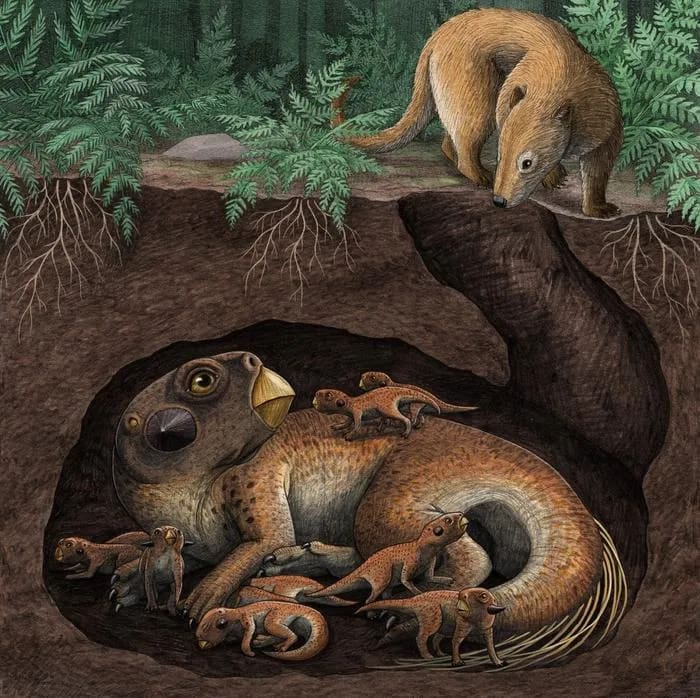Incredibly well preserved dinosaurs at China fossil site were thought to have been buried in huge volcanic eruptions, similar to the Mount Vesuvius that covered the city of Pompeii 2,000 years ago. But new research says this isn’t how things happened.
The Yixian Formation was referred to as the “Pompeii” of the dinosaur world for many years. Paleontologists can find some of the finest preserved fossils on Earth in this early Cretaceous rock in northeastern China, which offers a glimpse into life 130–120 million years ago.
Because Mount Vesuvius blanketed the city of Pompeii in 19 feet (6 meters) of ash in 79 AD, researchers thought that the ash from volcanic eruptions preserved the formation’s fossils.
However, recent research offers a startling twist: instead of being entombed by volcanic explosions, these ancient species would have been trapped in collapsing tunnels.
The Yixian Formation is a treasure trove of rare and well-preserved fossils. Animals with internal organs, feathers, scales, hair, and stomach contents have been found during previous excavations. Even an early animal the size of a cat engaged in lethal fight with a little dinosaur was discovered in 2023.
There are two types of fossils: three-dimensional, realistic skeletons and flattened specimens discovered in lake deposits. At first, the latter were believed to have been frozen in time by cataclysmic volcanic occurrences that buried them in volcanic rubble.
However, the latest study, which was published in the journal PNAS on November 4, suggests that a less spectacular reason probably preserved many of these fossils.
Scientists examined zircon samples extracted from the fossils to look for hints about how they were preserved. When uranium is formed, zircon, a mineral that frequently occurs in volcanic rocks and fossils, traps it while keeping lead out. Due to its radioactivity, uranium gradually transforms into lead over millions of years.
The scientists discovered that the fossils in the Yixian Formation were deposited quickly, around 125.8 million years ago, in a period of only 93,000 years, which is far shorter than previously believed, by calculating the ratio of uranium to lead in zircon.
Sediments accumulated in lakes and on land much more quickly than anticipated during this time due to three spells of rainy weather. The oxygen that ordinarily promotes decomposition was locked out, and many of the dead animals were promptly buried.

In lakes, where sediments piled so quickly that soft tissues could be preserved in great detail, the effect was most noticeable.
The results of the study cast doubt on the long-held belief that the fossils were preserved by volcanic activity. Previously, some scientists hypothesized that these animals were covered by lahars, which are fast, concrete-like mud flows caused by volcanic eruptions. Paul Olsen, the primary author of the new study and a paleontologist at Columbia Climate School’s Lamont-Doherty Earth Observatory, says this explanation is implausible since lahars are incredibly destructive and would probably tear apart any live or dead organism in their path.
Another widely held belief was that the fossils were buried by pyroclastic flows, which are swift waves of flaming ash and gas, much like Mount Vesuvius entombed the people of Pompeii. The inhabitants of Pompeii were famously knocked down by these floods, which subsequently covered their remains in layers of ash, keeping them in place. Because their muscles tensed and their internal fluids boiled, victims of the extreme heat assumed “pugilistic” postures, drawing their limbs tightly within.
Although the Yixian Formation contains layers of lava, volcanic ash, and magma intrusions, the scientists contend that the fossils do not exhibit the telltale symptoms of a Pompeii-style death. The Yixian animals’ feathers, fur, and other tissues would have probably burned if they had been covered by pyroclastic flows.
Many Yixian animals were discovered with their limbs securely nestled about their bodies, as though they were sleeping at the time of their death, rather than in pugilistic postures. The researchers suggest that abrupt tunnel collapses—possibly caused by massive dinosaurs trampling on the earth above, which had grown unstable due to the rainy weather—are the cause of death.
According to a statement from Olsen, “these are probably the most important dinosaur discoveries of the last 120 years.” However, the remarks made regarding their preservation technique draw attention to a significant human bias. That is, to attribute remarkable causes—that is, miracles—to everyday occurrences when we are unsure of their reasons. These [fossils] are only a snapshot of regular deaths that occurred over a comparatively short period of time under typical circumstances.